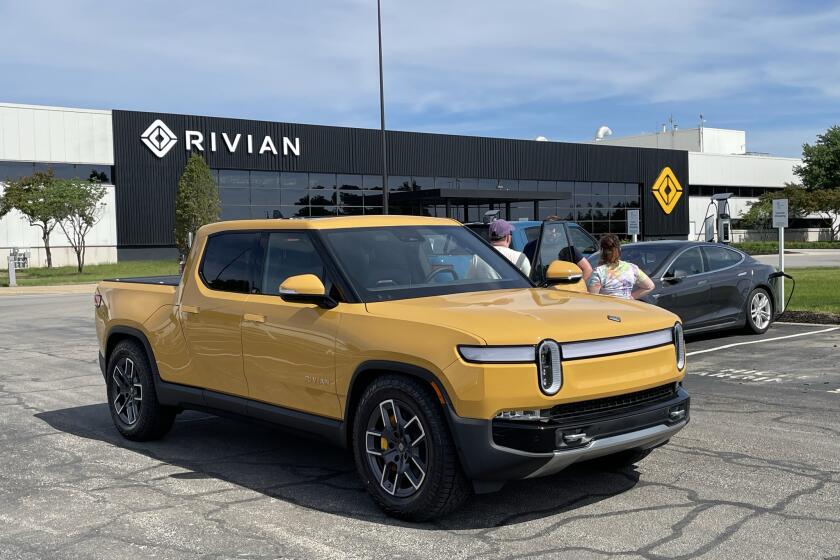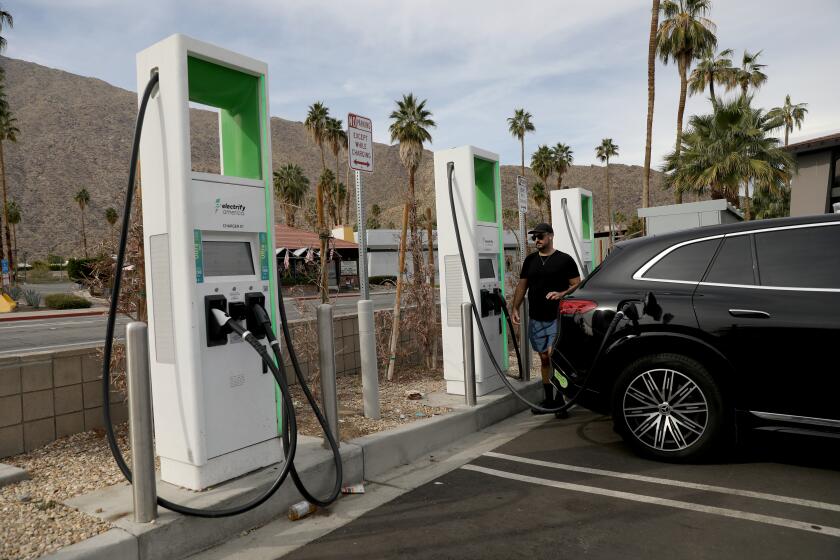Electric Car Buffs Shift Efforts Into Higher Gear : Smog: The DMV says 4,000 licensed vehicles are already humming along on batteries. Fear of interrupted oil supplies is a reason for the demand.
Richard Mayer, a lanky Van Nuys High School auto-shop teacher, commutes 23 miles to work from Santa Clarita in a white 1972 Volkswagen Bug, an unlikely vehicle in which to ride on the cutting edge of technology.
Mayer’s car, however, has 16 off-the-shelf 6-volt batteries--eight under the hood and eight behind and under the back seat--powering a 30-horsepower electric motor that is soundless except for the whir of a cooling fan.
From the outside, the virtually non-polluting vehicle looks the same as any of the exhaust-spewing cars with which it shares the highway. And the only difference from behind the wheel is that the car idles in gear without depressing the clutch, is slightly slower to accelerate and can be driven only about 60 miles before needing to be recharged.
Like many people who drive such hybrid cars, Mayer converted the vehicle himself.
But Mayer and a business partner, Donald Eaton, formed the Electric Car Co. of America to do the same for others. Headquartered at a desk in Eaton’s North Hollywood debt-collection agency, the company is unique in the San Fernando Valley.
Although the company has yet to sell any of its conversions, which can run as much as $15,000, Eaton said there is a “huge market out there” of environmentally aware consumers.
“Somebody has to make the first step toward producing these cars, and I’m glad I’m doing it,” said Mayer, 40, who has a degree in vocational education from Cal State Los Angeles. “In the near future, we’re going to have to go to electric cars . . . and the car companies are dragging their feet.”
While the automobile industry and government agencies responsible for reducing air pollution are predicting that electric vehicles won’t be widely available until far in the future, for a cadre of Southern California motorists, the future is now.
The California Department of Motor Vehicles said 4,000 licensed vehicles are already humming along on batteries. Companies that sell electric cars report growing sales. So do the expanding number of shops and mechanics, such as Mayer, who do conversions, and the parts shops that supply the necessary equipment. And several colleges, including Pasadena City College, are designing courses to train mechanics to convert internal-combustion engines to run on electricity.
Electric cars have actually been around since the turn of the century and are widely used in several European countries. In this country, hobbyists have tinkered with battery-powered cars for many years, and the number of people seeking electric cars surged during the 1973 and 1979 gas crises, subsiding only recently.
Part of the growing interest today, retailers and converters say, can also be attributed to fears of an interruption of oil supplies by the war in the Persian Gulf. But of equal concern is a greater awareness of environmental damage, especially in Los Angeles, resulting from the nation’s relatively high dependence on oil for energy.
“We noticed a real increase with the beginning of 1990, long before the Middle East situation . . . and then in August, it really went into orbit,” said Shari Prange, a co-owner of Brown’s Electro Automotive, a parts supplier near Santa Cruz.
Solar Electric Engineering, based in Santa Rosa, sells conversion kits but also markets a sedan known as the Electron for $15,700 and a sports car dubbed the Destiny for $28,000. The company made 40 cars over the past two years but plans to build 200 this year.
“What we’re trying to prove . . . is that there are vehicles being produced today that can meet most of people’s needs,” said Gary Starr, the company’s chief executive officer. “A lot of people, especially people in Detroit, think that you need to redesign the wheel.”
Most conversions and from-scratch electric vehicles have a range of between 50 and 125 miles before needing recharging, and the batteries must be replaced every three to four years, at a cost of about $800. They can travel at normal highway speeds, but some slow to a crawl on steep hills. The two greatest challenges in overcoming those limitations are reducing the weight of the cars and improving the efficiency of their batteries.
Not surprisingly, skeptics abound. Most motorists, inseparably wed to cars that can lay rubber and travel great distances, regard the electric autos as inconvenient oddities. Even those working to widen acceptance of electric vehicles say conversions have safety problems related to weight distribution and a lack of power for emergency situations on highways.
Price can also be a barrier. The cost of conversions ranges from $7,000 to $20,000 if done commercially, and the conversion is too complex for most garage hobbyists, said Howard Letovsky, a Los Feliz mechanic who has worked on 35 new and converted vehicles since going into business a year ago.
Even electric car gurus acknowledge that those available today are best suited to be second cars used mostly for driving short distances.
Bruce Severance, vice president of the newly formed 25-member Electric Auto Assn. in Pasadena, said studies have shown that the average family’s second car is used only 27 miles a day “so even an electric vehicle that had a range of 50 miles a day would meet the needs of a very large market.” Eaton cited U. S. Department of Transportation studies that suggest that as much as 30% of the auto usage in Los Angeles County could be electric without inconveniencing motorists.
Among those who are convinced is television and movie actor Ed Begley Jr., who lives in Studio City and drives only his two electric cars, which he recharges using solar energy.
Gary Starr of Solar Electric demonstrated two models in Los Angeles earlier this month and found buyers in such celebrities as Ted Danson, Kirstie Alley and Woody Harrelson, actors who star in the “Cheers” television show, as well as Alan Alda and Dennis Weaver. Writer-director Dennis Zucker owns one of Starr’s cars, and another is featured in his new movie, “Naked Gun 2 1/2,” which is a spoof about the nuclear and oil industries.
The South Coast Air Quality Management District bought one of the vehicles after a demonstration for its commissioners.
Staff members for Los Angeles City Councilman Joel Wachs, who represents the northeast San Fernando Valley, will soon be driving around town in a one-ton, battery-powered van prototype to be called the Wachsmobile. It is one of six purchased by the Department of Water and Power for testing.
“I think it’s going to really work well,” Wachs said. “We’ll be out there 45 miles worth a day, surveying the district and responding to constituent problems. At the same time, we’ll see how a vehicle like this works.”
To give a boost to electric vehicles, the DWP in January began offering a $20-a-month discount to customers who own them, and Southern California Edison is considering applying to the Public Utilities Commission to allow it to offer a similar discount.
“This is an experiment,” said Jerry Enzenauer, who manages a DWP program that is encouraging production and use of electric cars. “We’re trying to shake the tree and see how many of these folks are out there now . . . to collect information on usage, maintenance and such things.”
Even without the discount, Mayer and Eaton had calculated that it cost 3 1/2 cents per mile to operate an electric vehicle; it costs 8 1/2 cents per mile for one powered by gas. “You’re not going to save enough money on electricity to pay for the car, but the environmental savings and oil savings, that’s where the key is,” Mayer said.
The first person to express interest in receiving the DWP discount was Michael Bell, a voice animator who lives in Encino and who has been driving an electric 1981 Datsun truck for about six weeks. Despite some troubles--he didn’t charge the batteries completely the first day he used it and ran out of power several miles from home--he’s enthusiastic.
“For a housewife, or a person who works in the Valley, or someone who goes five or 10 miles and parks,” it is fully functional, said Bell. “They do it in Sweden and . . . we can do it here.”
For Bell, who is involved in such causes as water conservation, animal rights and control of the use of pesticides, driving an electric car seemed an extension of his activism.
Such people, Severance said, will buy the majority of electric vehicles in the near future because internal-combustion engines are the biggest single source of air pollution in Los Angeles.
The DWP estimates that 70% to 80% of Los Angeles-area air pollution is caused by emissions from the 8 million cars and trucks that operate here daily. Electric vehicles create only 3% as much air pollution as comparable gas-powered vehicles, even when figuring in the pollution caused by electrical generating plants.
The DWP, along with Edison, has invested $7 million in a Swedish company called Clean Air Transport, which hopes to have 1,000 of its electric cars for sale in Los Angeles by the middle of next year. DWP officials said they hope that their efforts to encourage the use of electric cars will persuade the AQMD to ease pollution restrictions being placed on DWP and Edison power plants.
The state Air Resources Board has decreed that by 1998, 2% of all new cars sold in the state will run on batteries. And the South Coast AQMD’s clean-air plan is counting on 17% of the cars in the Los Angeles Basin to be running on nearly pollution-free electricity by the year 2010.
General Motors, Ford and Chrysler are working on building vehicles to satisfy those rules but say they are not yet ready to go into mass production.
GM is testing an electric car called the Impact but has kept secret its release date, price and other specifications. Company spokesman Don Postma said last week that the car would be released “a lot sooner than most people believe.”
Postma said the Impact would be designed to go relatively short distances. Eventually, however, “to be successful, electric vehicles have to be able to do the same kinds of things that cars can today.”
Paul MacCready, developer of the Impact, said the few conversions and other electric vehicles on the road today will do little to help the environment and reduce oil consumption. “I don’t want to throw cold water on this . . . but making an electric car that has less performance and is slower and a little more dangerous than a regular car doesn’t help all that much,” he said.
“I think the big benefit is in the way it focuses your attention on the fact that we have to change our goals and values somewhat. It makes a statement, and that’s important.”
But for enthusiasts like Axel Axelsson, president of the Electric Auto Assn., there is no time to waste in developing cars that will help solve the environmental, political and economic problems that are caused by dependence on foreign oil.
“It’s just a wonderful step in the right direction,” he said. “The electric car is our most effective sword in our fight against air pollution.”



